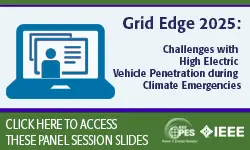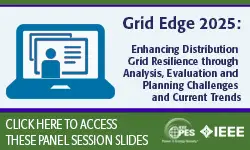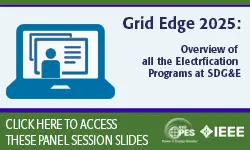-
Members: FreePES
IEEE Members: $25.00
Non-members: $40.00Pages/Slides: 51
Panel
13 Sep 2022
This panel session contains the following presentations:
1. A Design Method for Sub-Synchronous Oscillation Stability Analysis and Damping Control Generated by Wind Power Through Soft Straight Grid Connection
With the continuous access of new energy and HVDC transmission, the traditional AC transmission system has been expanded into a diversified, flexible, power electronic new energy network, the study of the stability of the traditional AC power grid is obviously unable to meet the demand, for the wind farm by soft straight grid generated by the sub-synchronous oscillation problem, this paper proposes that under the traditional V/F control strategy, do not change the original control parameters of the system, The additional damping control link improves the damping of the system to suppress the resonant peak and achieve the purpose of suppressing the sub-synchronous oscillation of the system.
2. Dynamic Battery Topology Construction Methods for Large-Scale Reconfigurable Battery Networks
With the increasing demand for large-scale application of high-voltage and large-capacity battery energy storage systems, battery cells are connected in series/parallel to form battery modules, and multiple battery modules are connected in series/parallel through DC/DC isolation stages. The method of increasing the voltage and current level through the energy storage power conversion system in series or parallel on the AC side has a significant short-board effect. Based on the dynamic reconfigurable battery network technology, this paper proposes a new dynamic battery topology generating methods that solves the short board effect, and no additional equalization circuit is required. Based on the Thevenin model of lithium-ion batteries, a continuous-time dynamic optimization model is established for the network and considering the actual engineering situation. Then, the dynamic reconfigurable battery network optimization problem is transformed into a linear mixed integer programming model based on discrete time. Finally, the validity of the proposed topology is verified and its performance is quantitatively analyzed by solving an example.
3. SPWM Control Rectification Technology of Free Piston Stirling Linear Generator Connected with DC/DC Converter for Storage Energy
With the increasing concern about fossil energy consumption and environmental pollution worldwide. In this case, a Stirling engine with diversified heat sources and low pollution has been developed, and the Free Piston Stirling Linear Generator (FPSLG), which can be directly connected with the Stirling engine and can save the intermediate mechanical transmission mechanism, has been used to form a power generation system with the Stirling engine. The FPSLG can realize the direct conversion of all kinds of heat energy to electrical energy by coupling the power piston of the free-piston Stirling engine and the mover of the linear motor. In this paper Sine Pulse Width Modulation (SPWM) control methods adaption to the AC/DC rectifier and the two-loop control method adaption to the buck-boost dc/dc converter used for renewable energy conversion is proposed. The idea is to transform this renewable energy into electrical energy, the FPSLG with rectifier and dc/dc converter has been used for energy conversion to the storage battery. Finally, to confirm the offered control approach and simulation results, the two control strategies are confirmed. The testing and implementation of the DQ-PI current controller using the SPWM technique for the Source Voltage Rectifier (SVR) and the two-loop PI technique used for the dc/dc converter were presented and the result was confirmed. The SPWM strategy has been used for converter link linear generator converter and as well storage battery side converter used two-loop PI controller. A completely renewable energy system FPSLG through the battery linking has been placed together to create the full system to be a new renewable energy source for upcoming electricity generation. This model system can use for implementation in laboratory work (experiment) in the future.
1. A Design Method for Sub-Synchronous Oscillation Stability Analysis and Damping Control Generated by Wind Power Through Soft Straight Grid Connection
With the continuous access of new energy and HVDC transmission, the traditional AC transmission system has been expanded into a diversified, flexible, power electronic new energy network, the study of the stability of the traditional AC power grid is obviously unable to meet the demand, for the wind farm by soft straight grid generated by the sub-synchronous oscillation problem, this paper proposes that under the traditional V/F control strategy, do not change the original control parameters of the system, The additional damping control link improves the damping of the system to suppress the resonant peak and achieve the purpose of suppressing the sub-synchronous oscillation of the system.
2. Dynamic Battery Topology Construction Methods for Large-Scale Reconfigurable Battery Networks
With the increasing demand for large-scale application of high-voltage and large-capacity battery energy storage systems, battery cells are connected in series/parallel to form battery modules, and multiple battery modules are connected in series/parallel through DC/DC isolation stages. The method of increasing the voltage and current level through the energy storage power conversion system in series or parallel on the AC side has a significant short-board effect. Based on the dynamic reconfigurable battery network technology, this paper proposes a new dynamic battery topology generating methods that solves the short board effect, and no additional equalization circuit is required. Based on the Thevenin model of lithium-ion batteries, a continuous-time dynamic optimization model is established for the network and considering the actual engineering situation. Then, the dynamic reconfigurable battery network optimization problem is transformed into a linear mixed integer programming model based on discrete time. Finally, the validity of the proposed topology is verified and its performance is quantitatively analyzed by solving an example.
3. SPWM Control Rectification Technology of Free Piston Stirling Linear Generator Connected with DC/DC Converter for Storage Energy
With the increasing concern about fossil energy consumption and environmental pollution worldwide. In this case, a Stirling engine with diversified heat sources and low pollution has been developed, and the Free Piston Stirling Linear Generator (FPSLG), which can be directly connected with the Stirling engine and can save the intermediate mechanical transmission mechanism, has been used to form a power generation system with the Stirling engine. The FPSLG can realize the direct conversion of all kinds of heat energy to electrical energy by coupling the power piston of the free-piston Stirling engine and the mover of the linear motor. In this paper Sine Pulse Width Modulation (SPWM) control methods adaption to the AC/DC rectifier and the two-loop control method adaption to the buck-boost dc/dc converter used for renewable energy conversion is proposed. The idea is to transform this renewable energy into electrical energy, the FPSLG with rectifier and dc/dc converter has been used for energy conversion to the storage battery. Finally, to confirm the offered control approach and simulation results, the two control strategies are confirmed. The testing and implementation of the DQ-PI current controller using the SPWM technique for the Source Voltage Rectifier (SVR) and the two-loop PI technique used for the dc/dc converter were presented and the result was confirmed. The SPWM strategy has been used for converter link linear generator converter and as well storage battery side converter used two-loop PI controller. A completely renewable energy system FPSLG through the battery linking has been placed together to create the full system to be a new renewable energy source for upcoming electricity generation. This model system can use for implementation in laboratory work (experiment) in the future.
Chairs:
Michael Joseph


